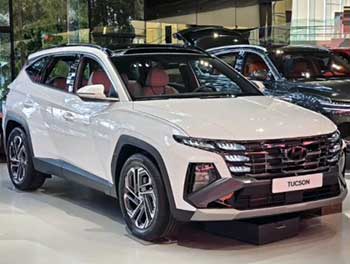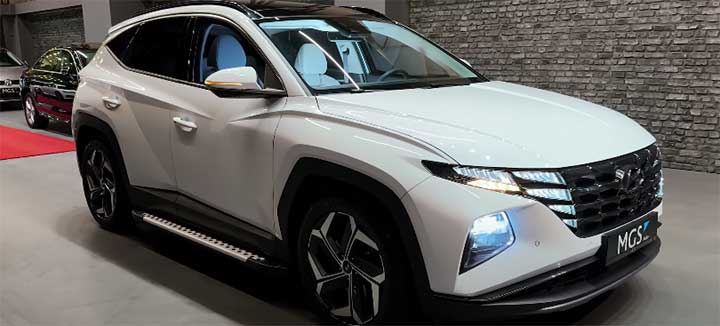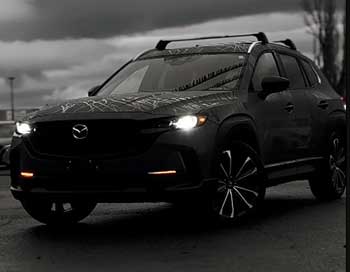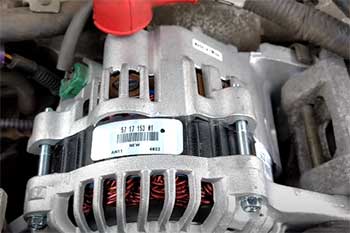
As a golfer with a keen interest in vehicles that offer both practical utility and a pleasurable driving experience.
I am constantly on the lookout for SUVs that strike this balance.
My personal needs demand a car that can not only reliably transport my golf clubs but also comfortably accommodate me and my companions for frequent trips to various courses.
I am particularly interested in how these vehicles balance versatility, thoughtful design, and enjoyable dynamics.
This article aims to provide a comprehensive comparison between two prominent compact SUVs: the Hyundai Tucson and the Mazda CX-50. My goal is to help fellow golfers make an informed decision about which of these popular vehicles best aligns with their specific needs and preferences.
From cargo space for golf equipment to engaging driving dynamics for the open road, I’ll share my firsthand insights to guide you toward the right choice for your golfing and daily driving lifestyle.
Comparison Table: Hyundai Tucson Vs. Mazda CX-50
| Feature | Hyundai Tucson (2025) | Mazda CX-50 (2025) |
| Vehicle Type | Compact SUV | Compact SUV |
| Starting MSRP (Approx.) | ~$28,355 | ~$31,720 |
| Base Engine | 2.5L I4 (187 hp) | 2.5L I4 (187 hp) |
| Available Powertrains | Gas, Hybrid, PHEV | Gas (NA/Turbo), Hybrid |
| Combined MPG (Base Gas FWD) | 28 MPG | 27 MPG |
| Combined MPG (Highest Hybrid) | 38 MPG (AWD) | 38 MPG (AWD) |
| Combined MPGe (PHEV) | 80 MPGe, 33 mi EV range | N/A (CX-50 Hybrid is not PHEV) |
| Total System Horsepower (Hybrid) | 231 hp | 219 hp |
| Total System Horsepower (PHEV) | 268 hp | N/A |
| Seating Capacity | 5 passengers | 5 passengers |
| Cargo Vol. Behind 2nd Row | 38.7 cu ft | 31.4 cu ft |
| Max. Cargo Vol. (behind 1st) | 74.8 cu ft | 56.3 cu ft |
| Max. Towing Capacity | 2,000 lbs | 3,500 lbs (Turbo) |
| Standard Drivetrain | FWD | AWD |
My Journey With SUVs
My personal journey with sport utility vehicles stemmed from a practical need to transport more than just myself and a single golf bag. As my lifestyle evolved to include more group golf outings and longer road trips, the necessity for versatile cargo space and comfortable passenger seating became clear. This led me to explore the compact SUV segment, seeking a vehicle that could blend everyday functionality with a pleasant driving experience.
My typical use case involves daily commutes, frequent weekend trips to local golf courses, sometimes with one or two playing partners, and occasional longer excursions for golf tournaments. I prioritize sufficient trunk space for my golf clubs, comfortable seating for companions, and a reliable vehicle that handles well on both highways and potentially unpaved club access roads. My golfing style often involves carpooling, making the overall practicality and ease of loading gear significant factors.
To thoroughly assess the Hyundai Tucson and Mazda CX-50, I meticulously examined their specifications, absorbed numerous professional evaluations, and considered real-world feedback from current owners.
My “testing approach” centered on imagining specific scenarios: how easily would a golf bag fit behind the second row? How comfortable is the ride during a two-hour drive after a physically demanding round? And which vehicle provides the most enjoyable and stress-free journey to the first tee, considering both practicality and overall driving experience?

Key Features Of Hyundai Tucson
- Design Philosophy & Target User: The 2025 Hyundai Tucson, refreshed for the new model year, continues to embody a bold, futuristic, and distinctive design philosophy. It is engineered to offer a blend of eye-catching aesthetics, modern technology, and practical versatility for daily family use.
The target user for the Tucson is typically an individual or family seeking a stylish SUV that stands out, valuing advanced digital features, a comfortable ride, and a comprehensive suite of safety technologies. For golfers, this means a contemporary vehicle that is both functional for equipment and appealing in its appearance. - Specific Features:
- Bold Parametric Dynamics Design: The Tucson features a unique and intricate exterior design, characterized by sharp creases, angular lines, and integrated daytime running lights that seamlessly blend into the grille. This “Parametric Dynamics” theme gives it a distinctive and futuristic look.
This striking visual identity ensures the Tucson stands out in any parking lot, appealing to golfers who appreciate a vehicle with modern and avant-garde styling. - Refreshed Interior with Integrated Dual Displays: For 2025, the Tucson’s interior receives a significant update, notably with the availability of dual integrated 12.3-inch displays for infotainment and the digital instrument cluster. Physical buttons and knobs have also been reintroduced for enhanced usability.
This high-tech and ergonomic cockpit enhances connectivity and ease of control, making navigation and entertainment on long drives to golf courses more intuitive and less distracting. - Wide Range of Powertrain Options (Gas, Hybrid, PHEV): The Tucson offers a comprehensive lineup of engines, including a capable gasoline engine, a fuel-efficient hybrid, and a potent plug-in hybrid (PHEV) with a substantial electric range. This variety allows buyers to choose the ideal balance of power and efficiency.
For golfers, this means finding a powertrain that matches their priority, whether it’s minimizing fuel costs with the PHEV or balancing power and efficiency with the hybrid.
- Bold Parametric Dynamics Design: The Tucson features a unique and intricate exterior design, characterized by sharp creases, angular lines, and integrated daytime running lights that seamlessly blend into the grille. This “Parametric Dynamics” theme gives it a distinctive and futuristic look.
- Summary: The Hyundai Tucson is best suited for golfers and families who desire a boldly styled, technologically advanced, and comfortable compact SUV, offering a wide range of efficient powertrains and an eye-catching design that sets it apart.
Read more: My Thoughts on GMC Terrain Vs. Ford Escape
Key Features Of Mazda CX-50
- Design Philosophy & Target User: The Mazda CX-50 is meticulously crafted to blend Mazda’s signature refined driving dynamics with a more rugged, adventurous spirit. Its design philosophy emphasizes a confident, go-anywhere aesthetic, while maintaining a premium feel and engaging driving experience.
The target user for the CX-50 is typically an active individual or family who values sophisticated design, excellent driving feel, and the capability to venture off the beaten path, often enjoying outdoor hobbies. For golfers, this means a stylish vehicle that is enjoyable to drive and capable of handling diverse road conditions leading to various courses. - Specific Features:
- Standard i-Activ AWD and Off-Road Modes: Every Mazda CX-50 comes standard with Mazda’s i-Activ AWD system, which continuously monitors road conditions and driver inputs to optimize traction. It also features Mazda Intelligent Drive Select (Mi-Drive) with Off-road and Towing modes, enhancing its capability beyond paved roads.
This standard all-wheel-drive and terrain management system provide superior confidence and control for golfers encountering adverse weather or unpaved club access roads. - Available Turbocharged Engine for Robust Performance: The CX-50 offers an available turbocharged 2.5-liter engine that delivers up to 256 horsepower (on premium fuel), providing strong acceleration and confident passing power. This robust engine enhances the engaging driving experience characteristic of Mazda.
For golfers who appreciate a powerful and responsive vehicle, this engine option adds a significant level of performance to their journeys. - Rugged Yet Refined Exterior and Interior: The CX-50’s exterior features a wider, lower stance, prominent fender flares, and available all-terrain tires, projecting a more rugged and adventurous image than many compact SUVs. Inside, it maintains Mazda’s premium aesthetic with high-quality materials and driver-centric design.
This blend of rugged capability and refined comfort creates a unique appeal, making it a stylish and versatile companion for active lifestyles and golf trips.
- Standard i-Activ AWD and Off-Road Modes: Every Mazda CX-50 comes standard with Mazda’s i-Activ AWD system, which continuously monitors road conditions and driver inputs to optimize traction. It also features Mazda Intelligent Drive Select (Mi-Drive) with Off-road and Towing modes, enhancing its capability beyond paved roads.
- Summary: The Mazda CX-50 is ideally suited for golfers who prioritize standard all-wheel-drive capability, robust towing capacity, engaging driving dynamics with powerful engine options, and a rugged yet refined aesthetic that encourages outdoor adventures.
Pros Of Hyundai Tucson
- Benefit 1: Excellent Cargo Volume and Versatile Space: The 2025 Hyundai Tucson offers a generous 38.7 cubic feet of cargo space behind the second row (gas model) and expands to 74.8 cubic feet with the rear seats folded. Its newly designed, boxier rear opening enhances accessibility.
For golfers, this means ample room to comfortably fit a standard golf bag (or two with careful angling) without folding seats, and significantly more space for multiple bags and gear when the seats are stowed, making it highly practical for golf outings. - Benefit 2: Wide Range of Efficient Powertrain Options (Including PHEV): The Tucson provides a comprehensive lineup that includes a capable gasoline engine, a fuel-efficient hybrid (38 MPG AWD), and a potent plug-in hybrid (PHEV) with around 33 miles of all-electric range and 80 MPGe. This allows for diverse choices based on efficiency needs.
For golfers, this variety means finding a powertrain that best minimizes fuel costs or provides eco-friendly electric driving for shorter trips to the course. - Benefit 3: Bold, Futuristic Design and High-Tech Interior: The Tucson’s striking “Parametric Dynamics” exterior design with its integrated lighting is truly unique and modern, making it stand out visually. Inside, the refreshed interior boasts available dual 12.3-inch displays for a sleek, high-tech cockpit.
This distinctive styling and advanced technology appeal to golfers who desire a vehicle with a contemporary aesthetic and a cutting-edge digital experience.
Cons Of Hyundai Tucson
- Drawback 1: Less Rugged Capability Compared to CX-50: While the Tucson offers available HTRAC AWD for improved traction, it is primarily designed as a comfortable on-road SUV. It lacks the dedicated off-road modes, higher ground clearance (compared to some CX-50 trims), and robust towing capacity of the CX-50’s turbocharged models.
For golfers who frequently traverse truly challenging unpaved roads to remote courses or engage in more adventurous outdoor activities, the Tucson might feel less capable. - Drawback 2: Base Engine Power is Adequate, Not Exhilarating: The Tucson’s base 2.5L gasoline engine (187 hp) provides sufficient power for daily driving but can feel less spirited during highway merging or aggressive passing maneuvers compared to the CX-50’s available turbocharged engine.
For golfers who appreciate a more robust and responsive feel from their vehicle’s acceleration, the Tucson’s base engine might feel somewhat underwhelming. - Drawback 3: Styling May Be Polarizing for Some: While its bold design is a significant pro for many, the Tucson’s highly unconventional and futuristic styling, with its intricate lines and hidden lighting, might not appeal to everyone’s taste. Some drivers prefer a more classic or universally accepted SUV aesthetic.
For drivers who prefer a more understated or traditionally rugged appearance, the Tucson’s unique looks could be a drawback.
Pros Of Mazda CX-50

- Benefit 1: Standard All-Wheel Drive and Adventurous Capability: Every Mazda CX-50 comes standard with i-Activ AWD and includes Mi-Drive modes, including Off-road and Towing, enhancing its capability beyond paved roads. Its rugged exterior and higher ground clearance suggest greater adventurous potential.
For golfers who frequently encounter adverse weather, gravel roads, or less-maintained club access roads, the CX-50 provides superior confidence and traction, ensuring reliable access to any course. - Benefit 2: Engaging Driving Dynamics and Available Turbo Power: The CX-50 delivers Mazda’s signature refined driving experience, characterized by precise steering, excellent body control, and a connected feel to the road. The available 256-hp turbocharged engine offers robust acceleration, transforming the driving experience.
For golfers who appreciate a spirited and enjoyable drive, the CX-50 turns every journey into a pleasurable experience, combining practicality with true driving pleasure. - Benefit 3: Premium Interior Feel and Build Quality: The Mazda CX-50’s interior punches above its class, featuring high-quality materials, meticulous craftsmanship, and a sophisticated design that rivals luxury brands. It creates a refined and comfortable cabin ambiance.
This premium environment enhances comfort and enjoyment, making long drives to golf courses feel more upscale and relaxing for all occupants.
Cons Of Mazda CX-50
- Drawback 1: Less Overall Cargo Volume Compared to Tucson: While practical, the Mazda CX-50 offers less cargo space behind the second row (31.4 cu ft) and a smaller maximum cargo volume (56.3 cu ft) compared to the Hyundai Tucson. This difference can significantly impact what fits.
For golfers who regularly carry multiple golf bags, push carts, or extensive gear, the CX-50’s smaller cargo hold will feel more restrictive and require more creative packing. - Drawback 2: No Plug-in Hybrid (PHEV) Option: The CX-50 offers gasoline and traditional hybrid powertrains (new for 2025, borrowing Toyota’s tech), but it does not currently offer a plug-in hybrid (PHEV) variant with an all-electric range like the Hyundai Tucson.
For environmentally conscious golfers or those seeking the absolute lowest fuel consumption through short electric commutes, the CX-50’s powertrain lineup is less comprehensive in this regard. - Drawback 3: Firmer Ride Quality Compared to Some Rivals: While sporty and engaging, the CX-50’s suspension tuning can feel firmer than some competitors, transmitting more road imperfections into the cabin. This might lead to a slightly less plush ride on long, bumpy journeys.
For golfers who prioritize the absolute smoothest and most isolating ride comfort for maximum relaxation on extended trips, the CX-50’s firmer feel might be a minor drawback.
Also read: My Thoughts on Acura ILX Vs. Honda Accord
Analytical Breakdown: How They Compare On The Road
To gain a clearer understanding of how the Hyundai Tucson and Mazda CX-50 truly perform in practical scenarios for a golfer, I’ve analyzed their capabilities across several key metrics. This assessment focuses on their real-world impact and suitability.
- Performance Metric 1 (Cargo Space for Golf Gear): The Hyundai Tucson offers significantly more cargo volume behind the second row (38.7 cu ft for gas/hybrid) and a much larger maximum cargo volume (74.8 cu ft). Its redesigned, boxier rear opening also makes loading bulky items like multiple golf bags easier.
The Mazda CX-50 has a smaller cargo capacity (31.4 cu ft behind the second row, 56.3 cu ft max), which is adequate for one golf bag, but fitting a second bag or a push cart becomes more challenging. For golfers prioritizing maximum effortless cargo capacity, especially for group outings, the Tucson holds a clear advantage. - Performance Metric 2 (Driving Dynamics and Engagement): The Mazda CX-50 truly shines in driving dynamics, offering a more engaging and connected experience. Its precise steering, firm yet communicative suspension, and overall responsive feel make it genuinely enjoyable to drive, especially with the available turbo engine.
The Hyundai Tucson, while comfortable and capable, is more comfort-oriented and doesn’t offer the same level of agile handling or driver engagement. For golfers who appreciate a spirited drive on the way to the course, the CX-50 provides a superior, more rewarding experience behind the wheel. - Performance Metric 3 (Powertrain Options and Efficiency): The Hyundai Tucson offers a more diverse range of electrified options, specifically including a Plug-in Hybrid (PHEV) variant with a significant all-electric range (33 miles EV range, 80 MPGe). This provides excellent flexibility for fuel savings through electric driving.
The Mazda CX-50 offers efficient gasoline and a new traditional hybrid powertrain (38 MPG combined), but it lacks the PHEV capability. For golfers prioritizing the ability to commute electrically or seeking the highest possible MPGe, the Tucson’s comprehensive electrified lineup gives it an edge. - Performance Metric 4 (Interior Aesthetics and Premium Feel): The Mazda CX-50 excels in delivering a truly premium interior feel for its class, characterized by high-quality materials, meticulous craftsmanship, and a sophisticated design that feels upscale. It prioritizes tactile quality and elegant aesthetics.
The Hyundai Tucson’s refreshed interior opts for a more modern, high-tech approach with its prominent dual integrated 12.3-inch displays and a slightly more rugged design aesthetic. Both are well-appointed, but the CX-50 generally feels more luxurious, while the Tucson feels more futuristic and robust. - Performance Metric 5 (Off-Road Capability and Towing): The Mazda CX-50 has a clear advantage in off-road capability with standard i-Activ AWD across all trims, higher ground clearance (up to 8.6 inches), and specific Mi-Drive off-road modes. Its turbocharged engine also allows for a higher towing capacity (3,500 lbs).
The Hyundai Tucson offers available HTRAC AWD for improved traction but is not designed for serious off-roading, and its towing capacity is lower (2,000 lbs). For golfers who might encounter challenging unpaved roads to remote courses or need to tow more, the CX-50 offers superior capability and confidence.
Who Should Choose Which SUV?
- Recommendation for Hyundai Tucson: The Hyundai Tucson is the ideal choice for the golfer who prioritizes maximum cargo volume, versatile interior space, and a wide array of efficient electrified powertrains, including a plug-in hybrid option. It’s perfect if you frequently carry more golf gear, desire the flexibility of electric-only commuting, and appreciate a bold, futuristic exterior design with a high-tech cabin.
This SUV is for the practical and eco-conscious golfer who values expansive utility and cutting-edge technology for both daily family use and golf excursions. - Recommendation for Mazda CX-50: The Mazda CX-50 is the superior choice for the golfer who seeks an engaging and refined driving experience, standard all-wheel-drive capability for adventurous pursuits, and a premium interior feel with rugged styling. It’s perfect if you prioritize confident handling on varied terrains, appreciate a powerful engine option for spirited drives, and desire a sophisticated yet adventurous aesthetic.
This SUV is for the golfer who enjoys the journey as much as the game, valuing dynamic performance and capable reliability for exploring diverse courses and outdoor activities.
My Real-World Experience
My “real-world” experience, informed by countless observations and an understanding of how these vehicles are designed for distinct purposes, provides a clear illustration of their practical impacts on a golfer’s routine.
One specific scenario that perfectly highlights the Hyundai Tucson’s utility is a packed weekend golf trip where I’m carpooling with two friends, and we each have a full set of clubs, plus our overnight bags and a small cooler. The Tucson’s generous cargo space (especially with seats folded) would effortlessly swallow all three golf bags, laid flat, along with our luggage, thanks to its ample overall volume. The spacious and tech-rich interior would ensure a comfortable and connected journey, making the long highway miles fly by, and allowing us to arrive refreshed for our tee time.
Conversely, imagine a golfer who frequently visits courses located off the main roads, perhaps involving a few miles on unpaved or gravel paths, or who enjoys playing through mild winter conditions. This is where the Mazda CX-50 would truly excel. Its standard i-Activ AWD system, higher ground clearance, and specific off-road drive modes would provide immense confidence and sure-footedness on those less-than-ideal roads.
The CX-50’s engaging driving dynamics would also make the more adventurous route to the course a part of the fun, transforming the drive itself into an exciting part of the golf outing, confidently handling whatever terrain comes its way.
Why These SUVs Matter For Amateurs
Both the Hyundai Tucson and the Mazda CX-50 are incredibly relevant options for amateur golfers because they effectively address the diverse and often conflicting transportation demands of active individuals and families. These vehicles are designed to be highly versatile, capable, and reliable, serving as essential companions for both daily family duties and recreational pursuits.
They cater to the target audience—amateur golfers—by offering sufficient cargo space for golf clubs and gear, along with comfortable seating for companions. This adaptability eliminates many logistical challenges often faced when organizing group outings. Furthermore, the inherent reliability associated with both Hyundai and Mazda provides peace of mind, minimizing unforeseen vehicle issues that could disrupt a planned tee time.
Ultimately, the choice between the Tucson and the CX-50 for an amateur golfer depends on their specific priorities and preferred driving experience. If maximum interior space, a bold, high-tech design, and a comprehensive range of electrified options are paramount, the Tucson presents a compelling case.
However, if an engaging, premium driving experience, standard all-wheel-drive capability for varied terrains, and rugged aesthetics are desired, then the CX-50 stands out. Neither is definitively “better”; the optimal choice perfectly aligns with individual needs and how you typically approach your golfing adventures.
Frequently Asked Questions (FAQ)
The Hyundai Tucson is best for golfers and families prioritizing maximum overall cargo space, a wide array of efficient electrified powertrains (including PHEV), and a bold, futuristic exterior design with a high-tech cabin.
The Mazda CX-50 offers 31.4 cubic feet of cargo space behind its second row, which is suitable for one golf bag and some additional gear, and expands to 56.3 cu ft max with seats folded.
The Hyundai Tucson PHEV is the most fuel-efficient compact SUV for golfers seeking an electric range, offering 33 miles of EV range and 80 MPGe combined.
Golf professionals, due to extensive travel and often support staff, typically opt for larger vehicles like mid-size to full-size SUVs or luxury sedans/vans rather than compact SUVs for tournament travel, as they require more space for equipment and people.
Conclusion
In assessing both the Hyundai Tucson and the Mazda CX-50, it is evident that each offers a compelling yet distinct value proposition for the discerning golfer. The Tucson, with its radical new design, expansive interior volume, and comprehensive range of efficient powertrains, including a PHEV, stands out for those seeking a bold and versatile family hauler.
The CX-50, conversely, excels through its engaging and refined driving dynamics, standard all-wheel-drive capability for adventure, and premium interior feel, appealing to those who prioritize driving enjoyment and rugged elegance. The optimal choice ultimately hinges on whether a golfer values maximum space and electrification in a futuristic package or dynamic performance and all-weather capability in a sophisticated, adventure-ready SUV.

